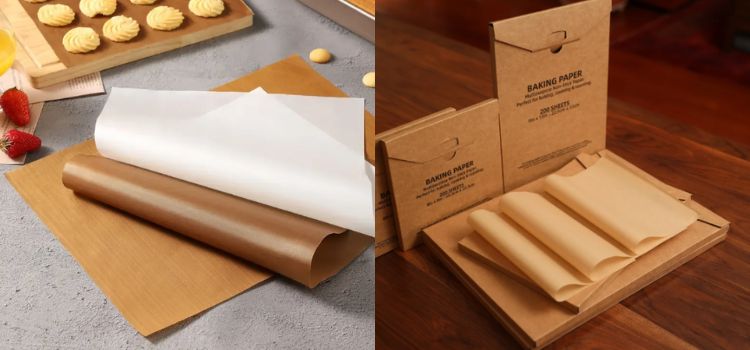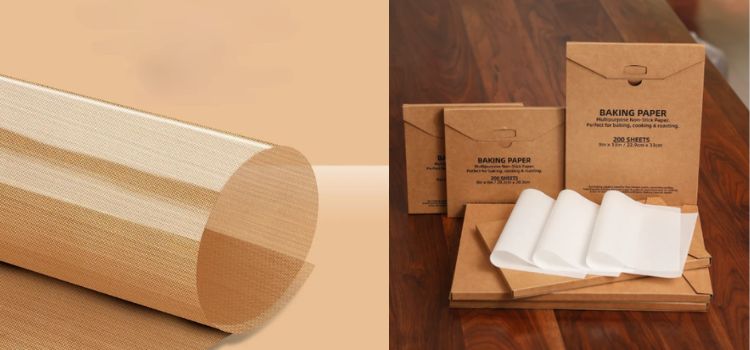As an Amazon Associate, I earn from qualifying purchases

In the realm of baking and cooking, the choice between a Teflon sheet and parchment paper can greatly affect the results of your culinary endeavors. Both options offer unique benefits and applications in the kitchen, making understanding their differences and advantages essential.
In this article, we delve into the distinct characteristics of Teflon sheets and parchment paper, exploring their uses, pros, and cons to help you make an informed decision for your next culinary endeavor.
What is a Teflon Sheet?
A Teflon sheet, a non-stick or silicone baking mat, is a thin sheet of heat-resistant material that can withstand high temperatures without melting or sticking. It is typically made from food-grade silicone with a Teflon (polytetrafluoroethylene or PTFE) coating on one or both sides.
Uses of Teflon Sheets
- Baking and roasting: A Teflon sheet is perfect for lining baking sheets, pans, and trays when making cookies, pastries, or roasted vegetables. It prevents sticking, making it easier to remove baked goods without any residue.
- Candy making: The non-stick surface of a Teflon sheet is ideal for working with sticky candy mixtures, such as caramel or toffee.
- Dehydrating: Teflon sheets are also suitable for dehydrating fruits and vegetables in the oven, preventing them from sticking to the baking tray.
- Freezing: These sheets can also be a non-stick surface for freezing foods such as meatballs or cookie dough. Once frozen, the food can easily be removed from the sheet without tearing or breaking.
- Reusable alternative to parchment paper: Teflon sheets are durable and reusable, making them an eco-friendly option for lining baking sheets and pans instead of using single-use parchment paper.
Pros and Cons of Using Teflon Sheets
Pros:
- Non-stick surface: As the name suggests, Teflon sheets have a non-stick surface that makes them perfect for baking and cooking.
- Easy to clean: Cleaning Teflon sheets is a breeze; all you need is warm water and a gentle cloth or sponge. They are also dishwasher safe.
- Heat-resistant: These sheets can withstand high temperatures without melting or releasing harmful chemicals.
- Durable and long-lasting: With proper care, Teflon sheets can last for years, making them a cost-effective option in the long run.
Cons:
- Not entirely non-stick: While Teflon sheets prevent food from sticking, some dough or batters may still stick to the surface.
- Not suitable for broiling: Teflon sheets should not be used under the broiler as they can melt or catch fire.
- Not biodegradable: Teflon sheets are made from synthetic materials that are not environmentally friendly and cannot be recycled.
What is Parchment Paper?
Parchment or baking paper is a thin sheet of paper coated with silicone or another non-stick material. It is typically made from unbleached and uncoated paper, making it biodegradable and environmentally friendly.
Uses of Parchment Paper
- Baking: Parchment paper is frequently utilized as a lining for baking sheets and pans, ensuring food does not adhere to the surface.
- Roasting: It can also serve as a liner for roasting dishes or trays, making removing roasted vegetables or meat easier without leaving any residue.
- Steaming: Parchment paper can be folded into pouches or packets for steaming fish or vegetables in the oven or stovetop.
- Wrapping food: Parchment paper is also commonly used to wrap foods such as fish, chicken, or vegetables before cooking in the oven. This method helps retain moisture and prevents sticking.
Pros and Cons of Using Parchment Paper
Pros:
- Easily accessible: Parchment paper is relatively inexpensive and widely available in most grocery stores.
- Non-stick surface: Similar to Teflon sheets, parchment paper has a non-stick surface ideal for baking and cooking.
- Easy cleanup: Parchment paper can be discarded after use, making cleanup quick and effortless.
- Multipurpose: Beyond its essential role in baking and cooking, parchment paper serves versatile functions, including wrapping food and crafting piping bags.
Cons:
- Not reusable: Unlike Teflon sheets, parchment paper cannot be reused, making it a less environmentally friendly option in the long run.
- Can tear easily: Parchment paper is not as durable as Teflon sheets and can tear easily when handling wet or heavy ingredients.
- Limited heat resistance: Parchment paper can only withstand temperatures up to 420°F, making it unsuitable for broiling or cooking at very high temperatures.
A Comparison: Teflon Sheet vs Parchment Paper

As mentioned earlier, Teflon sheets are made from food-grade silicone with a layer of PTFE coating. This composition makes them heat-resistant and durable, lasting for years with proper care.
Conversely, parchment paper consists of unbleached paper that has been treated with silicone or similar non-stick substances. While it is biodegradable and environmentally friendly, it is not as durable as Teflon sheets and cannot be reused.
Heat Resistance and Non-Stick Properties
Teflon sheets have a higher heat resistance than parchment paper. This makes them ideal for high-temperature baking in the oven. They also have superior non-stick properties, preventing food from sticking and creating an effortless cleanup process.
Parchment paper, on the other hand, has a lower heat resistance and may tear or burn when exposed to high temperatures. While it does have a non-stick surface, it is not as effective as Teflon sheets.
Conclusion
In conclusion, Teflon sheets and parchment paper have their uses and advantages. Teflon sheets are more durable and have better non-stick properties, making them ideal for baking and cooking at high temperatures. Parchment paper is more environmentally friendly but may be less effective in high-heat cooking.
In the end, selecting one over the other hinges on personal tastes and the unique requirements of the person involved. So, weighing the pros and cons mentioned above before deciding is essential. Happy baking and cooking!
As an Amazon Associate, I earn from qualifying purchases